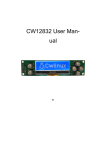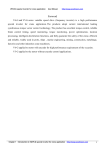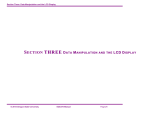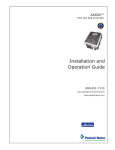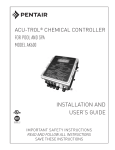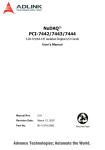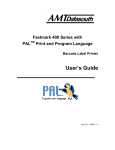Download CW1602 User Manual
Transcript
CW1602 User Manual
by
Cwlinux Ltd.
CW1602 Display
CW1602 User Manual
by Cwlinux Limited
Published April, 2003
Copyright 2003 Cwlinux Limited, All rights reserved.
Cwlinux Limited makes no representations or warranties with respect to CW1602 or to the
contents or use of this manual, and specifically disclaims any express or implied warranties
of merchantability of fitness for any particular purpose.
Permission is granted to copy and distribute modified versions of this documentation under
the conditions for verbatim copying, provided also that the entire resulting derived work is
distributed under the terms of a permission notice identical to this one.
Permission is granted to copy and distribute translations of this documentation into another
language, under the above conditions for modified versions.
Linux is a registered trademark of Linus Torvalds.
All trademarks, registered trademarks, and service marks are the property of their respective
owners.
CW1602 Display
Revision History
Author
Revision
Content
Date
IL
1
Initial released
12/04/03
IL
2
New features added
26/05/03
CW1602 Display
Table of Contents
Chapter 1.Introduction...................................................................................................................7
1.1.Introduction....................................................................................................................................7
1.2.Features...........................................................................................................................................7
1.3.Installation and Connection...........................................................................................................7
1.3.1.Serial Connection........................................................................................................7
1.3.2.Power Connection......................................................................................................8
1.3.3.USB Connection.........................................................................................................9
1.3.4.USB Driver.................................................................................................................10
1.3.5.USB driver for Windows...........................................................................................10
1.3.6.Keypad Pin Assignments.........................................................................................10
1.3.7.GPIO, Relay Pin Assignments................................................................................11
1.3.8.Contrast Adjustment.................................................................................................11
1.3.9.Installation.................................................................................................................12
1.3.10.Test the Module......................................................................................................12
1.3.11.Demo Software.......................................................................................................13
1.3.12.Serial Number Notation..........................................................................................14
Chapter 2.Module Programming................................................................................................15
2.1.Command Sending.......................................................................................................................15
2.2.Flowchart......................................................................................................................................15
Chapter 3.Text Mode..................................................................................................................16
3.1.Built in Characters.......................................................................................................................16
3.2.Writing Text to CW1602.............................................................................................................17
3.3.Text Commands...........................................................................................................................17
3.3.1.Auto Line Wrap ON (254 67 253)...........................................................................17
3.3.2.Auto Line Wrap OFF (254 68 253).........................................................................17
3.3.3.Text Insertion Point (254 71 [column] [row] 253)..................................................17
3.3.4.Set Text Insertion Point to Top Left (254 72 253).................................................17
3.3.5.Turn On Underline Cursor (254 74 [column] [row] 253).......................................17
3.3.6.Turn Off Underline Cursor (254 75 253)................................................................18
3.3.7.Turn On Blinking Block Cursor (254 89 [column] [row] 253)................................18
CW1602 Display
3.3.8.Turn Off Blinking Block Cursor (254 90 253)...................................18
3.3.9.Move Cursor Left (254 76 253)..........................................................18
3.3.10.Move Cursor Right (254 77 253).....................................................18
Chapter 4.Bar Charts, User Defined Characters and Graphics........................19
4.1.Introduction...........................................................................................................19
4.2.Command List.......................................................................................................19
4.2.1.Initialize Wide Vertical Bar Graph (254 118 253).............................19
4.2.2.Initialize Narrow Vertical Bar Graph (254 115 253).........................19
4.2.3.Draw Vertical Bar Graph (254 61 [column] [height] 253)................19
4.2.4.Erase Vertical Bar Graph (254 45 [column] 253).............................19
4.2.5.Initialize Horizontal Bar Graph (254 104 253)..................................19
4.2.6.Draw Horizontal Bar Graph (254 124 [column] [row] [length] 253)
........................................................................................................................19
4.2.7.Define Custom character (254 78 [cc] [8 bytes] 253)......................19
Chapter 5.Miscellaneous Commands..................................................................21
5.1.General Command List.........................................................................................21
5.1.1.Read Model Number (254 48 253)....................................................21
5.1.2.Read Firmware Version (254 49 253)...............................................21
5.1.3.Soft Reset (254 86 253).....................................................................21
5.1.4.Clear Display (254 88 253)................................................................21
5.1.5.Set RS232 port speed (254 57 [speed] 253)....................................21
5.2.Backlight Command List......................................................................................21
5.2.1.Backlight On (254 66 253)..................................................................21
5.2.2.Backlight Off (254 70 253)..................................................................22
5.2.3.Backlight Brightness (254 65 [brightness] 253)...............................22
5.3.Keypad Command List.........................................................................................22
5.3.1.Auto Key Hold On (254 50 253)........................................................22
5.3.2.Auto Key Hold Off (254 51 253)........................................................22
5.3.3.Keypad Mapping.................................................................................22
5.4.Non-Volatile Memory Command List.................................................................23
CW1602 User Manual
5
CW1602 Display
5.4.1.Save User Defined Character in Non-Volatile Memory (254 79 [cc]
253)................................................................................................................23
5.4.2.Load User Defined Character in System RAM (254 80 [cc] 253). .23
5.4.3.Save User Settings in Non-Volatile Memory (254 83 [ud] [4 bytes]
[4 dummy bytes] 253)...................................................................................23
5.4.4.Read User Settings from Non-Volatile Memory (254 84 [ud] 253)
........................................................................................................................23
5.4.5.Save Custom Startup Screen (254 64 [bb] [8 bytes] 253)..............24
5.5.GPIO Command List............................................................................................25
5.5.1.Turn ON General Purpose Output (GPO) (254 99 [gpo#] 253).....25
5.5.2.Turn OFF General Purpose Output (GPO) (254 100 [gpo#] 253). 26
5.5.3.Read Status of General Purpose Input (GPI) (254 101 [gpi#] 253)
........................................................................................................................26
Chapter 6.Command Summary............................................................................28
6.1.Text Command Summary.....................................................................................28
6.2.Bar Charts and Graphic Command Summary.....................................................29
6.3.Miscellaneous Command Summary....................................................................30
6.4.Text Mode Coordinates........................................................................................31
Chapter 7.LCD Specifications...............................................................................32
7.1.Physical Data.........................................................................................................32
7.2.Absolute Maximum Ratings (Ta = 25°C)............................................................32
Chapter 8.Appendix...............................................................................................34
CW1602 User Manual
6
CW1602 Display
Chapter 1. Introduction
1.1.
Introduction
The CW1602 is a character LCD which user can show both text and bar charts via a
connection of a computer/appliance/server. The module includes a set of simple commands
that allows user to develop their own LCD environment.
1.2.
Features
16 columns
2 lines text display
Built in characters plus 8 user defined characters
Communicate over RS232 or USB interface
Baud rate speed selection between 9600 and 19200 bps
Programmable brightness and on/off of LED backlight
Underline and blinking block cursors
Horizontal and vertical bar charts
32 bytes reserved non-volatile memory spaces for user settings
Non volatile memory spaces for 8 user defined characters
Non volatile memory spaces for startup screen
4 General Purpose I/Os
6 buttons keypad input interface
Fit in a standard half height 5
1.3.
1.3.1.
drive bay or 1U rack mount case
Installation and Connection
Serial Connection
Only simple connection is required. CW1602 obtains power from the PC standard floppy
power connector (Drawing 2). User should take extremely care in connecting the power to
CW1602. Reversing the polarity of the connector may result in burning the CW1602.
Drawing 1 shows how to connect the CW1602 to a Personal Computer, a 1U appliance or a
Server Station. For a serial CW1602, user only needed to connect a DB9 cable (Standard
COM port cable) together with a power cable (Standard Floppy Drive Power Cable).
CW1602 User Manual
7
CW1602 Display
Drawing 1 Serial connection diagram.
1.3.2.
Power Connection
Pin
1
2
3
Name 12V GND GND
4
5V
Drawing 2 Power
connector.
CW1602 User Manual
Drawing 3 Proper power plug.
8
CW1602 Display
User should take extremely care if he intended to connect it with another type of power
supply. Please notice the pin assignments of the power connector before plugging the
power plug into the CW1602.
Improper connection of the power may burn the
CW1602.
The bouncing reset switch SW1 is used to reset the micro-controller whenever necessary.
Remote reset switch can also be found in JP1, please refer to the GPIO in session 1.3.7.
1.3.3.
USB Connection
The Connection of a USB CW1602 is much more easier. The USB version of CW1602 can
be powered up by just connecting a USB cable. No other power supply is required as the
power comes from the USB cable itself. The LCD is on once the USB cable is connected.
Drawing 4 USB connection diagram.
CW1602 User Manual
9
CW1602 Display
1.3.4.
USB Driver
Driver of the USB version of CW1602 can be obtained at www.cwlinux.com/eng/downloads.
Type in the followings (only in Linux) to load the driver,
# tar zxf ld_pl2303_v0213.tar.gz
# cd ld_pl2303_v0213
# make
# modprobe usb-ohci or modprobe usb-uhci
# insmod usbserial.o
# insmod pl2303.o
Note: Although the stock version of Linux driver works, it has problem during high speed
transfer. This driver fixes the problem. It is recommended to use the above driver instead of
the stock driver.
1.3.5.
USB driver for Windows
Latest version of USB driver for CW1602 can be downloaded at http://tech.prolific.com.tw. In
the website, search for latest driver for PL2303. Then, install the driver according to the
readme file.
1.3.6.
Keypad Pin Assignments
Drawing 5 Keypad pin assignments
Pin
8
7
6
5
4
3
2
1
Name
GND
Cancel
Confirm
Right
Left
Down
Up
+5V
User may user the keypad, which Cwlinux provides it as an optional feature, or they may
connect their keypad according to the pin configuration of JA. The micro-controller returns
character only when one of the pins (Up, Down, Left, Right, Confirm or Cancel) is connected
to ground (pin 8).
CW1602 User Manual
10
CW1602 Display
1.3.7.
GPIO, Relay Pin Assignments
Drawing 6 GPIO pin assignments.
Pin
Name
1
2
3
GPO0 GPO1 GPI0
4
5
6
7
8
9
10
GPI1
RST
+5V
GND
GND
NC
NC
User can connect their external I/O devices to JP1. Detail description of the GPIO can refer
to sessions 5.5.1 to 5.5.3. RST is the reset pin of the
)(*
,+.-/ 01)(1232 , '4)(52 6798
1.3.8.
!" # #%$&
'
Contrast Adjustment
Drawing 7 Trimpot location.
User can change the contrast of the LCD by adjusting the trimpot R7. Notice the CW1602 is
shipped with default adjusted contrast voltage.
CW1602 User Manual
11
CW1602 Display
1.3.9.
Installation
The CW1602 can completely fit into a single 5 ¼ PC bay or a 1U rack mount, which may
enhance user to get display information (basically 2x16 characters) in only a small area. The
diagram drawn below shows how the module is mounting on a single PC bay insert.
Drawing 8 Installation of the CW1602.
1.3.10.
Test the Module
User may test the module in the following way,
1. Open the minicom
2. Press [Ctrl A] then [O] to bring up configuration
3. Choose “Serial port setup” in configuration
4. Change item A to /dev/ttyS0 if user is using the serial CW1602 and is connected to
COM1
5. Change item A to /dev/ttyS1 if user is using the serial CW1602 and is connected to
COM2
6. Change item A to /dev/ttyUSB0 if user is using the USB CW1602 and is connected
to USB port
7. Change item E to 19200 8N1 as this is the default value of CW1602 during power
up.
8. Exit “Serial port setup”
9. Choose “Save setup as dfl1” in configuration
10. Exit configuration
CW1602 User Manual
12
CW1602 Display
11. Re-open minicom
12. Type some characters on keyboard and it should appear on the LCD.
User may test the keypad in the following way,
1. Repeat step 1-11 as above.
2. Press a button on the keypad and it should have character echoed back (5.3.3)
corresponding to the button you pressed.
1.3.11.
Demo Software
User can download the demo software rpm from www.cwlinux.com/eng/downloads. Run the
rpm as the following,
$ rpm -Uvh lcdtest-1602-0.1-CWLINUX_1.i386.rpm
then, run the binary as the following,
$ lcdtest
With this demo software, user can test all basic functions of CW1602.
Drawing 9 Demo Software page 1.
CW1602 User Manual
13
CW1602 Display
Drawing 10 Demo Software page 2
1.3.12.
Serial Number Notation
We provide different versions of CW1602 for user to choose. User can choose the one which
suit to his application. Here listed below is some explanation of a serial number.
CW 1602 Y-KS
Item
Meaning
CW
CWlinux
1602
LCD character matrix size
Y
Backlight color
K
Keypad supported
S
S - Serial, U - USB
CW1602 User Manual
14
CW1602 Display
Chapter 2. Module Programming
2.1.
Command Sending
Commands are sent via the RS232 port together with 2 other numbers, the command starts
with [254] and ends at [253]. For example, in PC, user will need to write the following lines in
order to send a complete command to CW1602.
Void LCD_Write_Command(BYTE [command])
{…………
LCD_Write(254);
LCD_Write([command]);
LCD_Write(253);
………..
};
2.2.
Flowchart
Drawing 11 Flowchart.
CW1602 User Manual
15
CW1602 Display
Chapter 3. Text Mode
3.1.
Built in Characters
Size of all built in characters is defined by a 5 x 7 dot matrix. User is required to send the
ASCII code of the corresponding character in order to display it. Some of the common ASCII
characters are listed in the following table. Details of the font table please refer to the
appendix. Note: UD stands for User Defined.
ASCII
Character
ASCII
Character
ASCII
Character
ASCII
Character
1
UD
44
,
72
H
100
d
2
UD
45
-
73
I
101
e
3
UD
46
.
74
J
102
f
4
UD
47
/
75
K
103
g
5
UD
48
0
76
L
104
h
6
UD
49
1
77
M
105
i
7
UD
50
2
78
N
106
j
8
UD
51
3
79
O
107
k
9
52
4
80
P
108
l
10
53
5
81
Q
109
m
11
54
6
82
R
110
n
12
55
7
83
S
111
o
13
56
8
84
T
112
p
14
57
9
85
U
113
q
15
58
:
86
V
114
r
16
59
;
87
W
115
s
32
[space]
60
<
88
X
116
t
33
!
61
=
89
Y
117
u
34
“
62
>
90
Z
118
v
35
#
63
?
91
[
119
w
36
$
64
@
92
\
120
x
37
%
65
A
93
]
121
y
38
&
66
B
94
^
122
z
39
‘
67
C
95
_
123
{
40
(
68
D
96
`
124
|
41
)
69
E
97
a
125
}
42
*
70
F
98
b
126
->
43
+
71
G
99
c
127
<-
Table 1 Characters table
CW1602 User Manual
16
CW1602 Display
Apart from the built in characters listed in the above table, user can also define their own
characters in the spaces from [0x01] to [0x08] in CW1602. Details of how to define the
character may refer to section 4.2.7.
3.2.
Writing Text to CW1602
When user sends a character to CW1602, it displays at the location which defined before.
The next character will automatically display at the location next to the previous character.
Characters which are drawn please refer to the built in characters table showed above. User
wants to display their own characters will need to specify it in the user defined character
session.
3.3.
Text Commands
User may use the following commands to program CW1602. He may need to read chapter 2
to have better knowledge of how to send these commands accordingly.
The numbers
showed below are measured in decimal. A summary of different kinds of number system is
shown in chapter 6.
3.3.1.
Auto Line Wrap ON (254 67 253)
This command enables word wraps to next line when character reaches the end of a line.
Default is OFF.
3.3.2.
Auto Line Wrap OFF (254 68 253)
Disables line wrap. Character will return to the first position of the original line if it reaches
the end of a line. Default is OFF.
3.3.3.
Text Insertion Point (254 71 [column] [row] 253)
This command moves the text insertion point to the location which specified by [column] and
[row]. Column has the value ranging from 0 (0x00) to 15 (0x0F) and row has the value
ranging from 0 (0x00) to 1 (0x01).
3.3.4.
Set Text Insertion Point to Top Left (254 72 253)
This command sets the text insertion point to top left of the LCD. ie. [column] = 0 and [row] =
0.
3.3.5.
Turn On Underline Cursor (254 74 [column] [row] 253)
Turns on the underline cursor at position [column] and [row]. Default is OFF.
CW1602 User Manual
17
CW1602 Display
3.3.6.
Turn Off Underline Cursor (254 75 253)
Turns off the underline cursor. Default is OFF.
3.3.7.
Turn On Blinking Block Cursor (254 89 [column] [row] 253)
Turns on the underline cursor at position [column] and [row]. Default is OFF.
3.3.8.
Turn Off Blinking Block Cursor (254 90 253)
Turns off the underline cursor. Default is OFF.
3.3.9.
Move Cursor Left (254 76 253)
Moves cursor to left.
3.3.10.
Move Cursor Right (254 77 253)
Moves cursor to right.
CW1602 User Manual
18
CW1602 Display
Chapter 4. Bar Charts, User Defined
Characters and Graphics
4.1.
Introduction
The CW1602 offers the ability of drawing horizontal graphs, vertical graphs and text
simultaneously on the same screen. Details of how to draw the graphs are described as the
followings.
4.2.
4.2.1.
Command List
Initialize Wide Vertical Bar Graph (254 118 253)
This command defines the width of the vertical bar to 5 pixels. Default is OFF.
4.2.2.
Initialize Narrow Vertical Bar Graph (254 115 253)
This command defines the width of the vertical bar to 2 pixels. Default is OFF.
4.2.3.
Draw Vertical Bar Graph (254 61 [column] [height] 253)
The vertical bar graph is drawn at position [column] and row = 1 (the lower bottom) with the
[height] specified. The height can be ranging from 0 (0x00) to 16 (0x10).
4.2.4.
Erase Vertical Bar Graph (254 45 [column] 253)
The vertical bar graph is erased at position [column] and row = 1 (the lower bottom).
4.2.5.
Initialize Horizontal Bar Graph (254 104 253)
This command defines the horizontal bar. Default is OFF.
4.2.6.
Draw Horizontal Bar Graph (254 124 [column] [row] [length] 253)
The horizontal bar graph is drawn at position [column] and [row] with length [length] and goes
from left to right. The length can be ranging from 0 (0x00) to 80 (0x7A).
4.2.7.
Define Custom character (254 78 [cc] [8 bytes] 253)
The CW1602 allows user to define 8 extra characters by himself. These defined characters
are stored in location starting from [0x01] to [0x08] with the ASCII value in Table 1.
CW1602 User Manual
19
CW1602 Display
The characters are defined by sending the command 254 78 [cc] followed by 8 bytes. [cc] is
the character number starting from [0x01] to [0x08]. The 8 bytes are mapped as the following
table.
Data Byte
MSB
LSB
1
5
4
3
2
1
2
10
9
8
7
6
3
15
14
13
12
11
4
20
19
18
17
16
5
25
24
23
22
21
6
30
29
28
27
26
7
35
34
33
32
31
8
40
39
38
37
36
Table 2 User defined characters bit mapping.
A “1” bit represents an ON (Dark) pixel while a “0” represents an OFF (Clear) pixel. For
instance, if user wants to define the following heart in the character space 0x01, he may
need to send the following bytes to CW1602.
0xfe [start byte],
0x4e [command byte],
0x01 [character location],
0x0a, 0x1f, 0x1f, 0x1f, 0x1f, 0x0e, 0x04, 0x00 [8 bytes],
0xfd[stop byte]
Once defined, a character is displayed simply by sending a value from (0x01) to (0x08) which
is corresponding to the character number.
CW1602 User Manual
20
CW1602 Display
Chapter 5. Miscellaneous Commands
5.1.
5.1.1.
General Command List
Read Model Number (254 48 253)
This command enables user to read back the model number of CW1602. 2 bytes 16 [0x10]
and 2 [0x02], which represent the character matrix size, will be sent accordingly from
CW1602 to the host after this request command is sent.
5.1.2.
Read Firmware Version (254 49 253)
This command enables user to read back a 2-byte firmware version. For example, 2 bytes
0x01 and 0x00, which represent version V1.0, will be sent accordingly from CW1602 to the
host when it sends this request command to CW1602.
5.1.3.
Soft Reset (254 86 253)
This command resets the CW1602. Everything will start from startup screen again.
5.1.4.
Clear Display (254 88 253)
This command clears the entire screen and set the text insertion point to top left. ie. [Column]
= 0 and [Row] = 0.
5.1.5.
Set RS232 port speed (254 57 [speed] 253)
This command sets the RS232 port speed specified by [speed]. [speed] is a single byte
which specifies a desired port speed. Details of [speed] can refer to the following table.
Speed Byte
Baud Rate
0x20
9600
0x0F
19200
Table 3 Baud rate table. Default is 19200.
5.2.
Backlight Command List
5.2.1.
Backlight On (254 66 253)
This command turns on the LED backlight of the LCD with maximum brightness. Default is
ON.
CW1602 User Manual
21
CW1602 Display
5.2.2.
Backlight Off (254 70 253)
This command turns off the LED backlight of the LCD. Default is ON.
5.2.3.
Backlight Brightness (254 65 [brightness] 253)
User can adjust the brightness of the backlight LED by sending this command with 7 levels of
brightness. [brightness] ranges from 1 to 7 and 7 is the maximum while 1 is the minimum.
Please notice the maximum brightness can be obtained by backlight on command and
minimum brightness is obtained by backlight off command.
5.3.
5.3.1.
Keypad Command List
Auto Key Hold On (254 50 253)
This command enables the CW1602 to send character back continuously for every 0.5s if
one of the keys on the keypad is continuously hold down. Default is OFF.
5.3.2.
Auto Key Hold Off (254 51 253)
This command makes the CW1602 only to send a single character back when one of the
keys on the keypad is pressed or continuously hold down. Default is OFF.
5.3.3.
Keypad Mapping
CW1602 produces a single ASCII character while anyone of the keys is pressed. The single
bay panel buttons will produce the following characters. Notice all buttons have no direct
effect on the display. Characters are only sent to PC’s serial input. User must provide a
control program in PC such that correlates the button pressed to the desire function.
Key
Character Return
Up
"A" (Dec 65, 0x41h)
Down
"B" (Dec 66, 0x42h)
Left
"C" (Dec 67, 0x43h)
Right
"D" (Dec 68, 0x44h)
Confirm
"E" (Dec 69, 0x45h)
Cancel
"F" (Dec 70, 0x46h)
Table 4 Keypad character return.
CW1602 User Manual
22
CW1602 Display
5.4.
5.4.1.
Non-Volatile Memory Command List
Save User Defined Character in Non-Volatile Memory (254 79
[cc] 253)
User can save their predefined characters in the non-volatile memory and this will save much
time in redefining it again after the power of CW1602 is switched off and on. [cc] is the
character number starting from [0x01] to [0x08].
5.4.2.
Load User Defined Character in System RAM (254 80 [cc] 253)
During power up, user can load their redefined characters from non-volatile memory into the
system RAM by sending this command to CW1602. [cc] is the character number starting
from [0x01] to [0x08].
5.4.3.
Save User Settings in Non-Volatile Memory (254 83 [ud] [4 bytes]
[4 dummy bytes] 253)
The CW1602 reserves 32 bytes of non-volatile memory for arbitrary use by the host. This
memory could be used to store a serial number, IP address, gateway address, netmask or
any other data required.
[ud], which starts from 1 [0x01] to 8 [0x08], is the location of a data.
5.4.4.
Read User Settings from Non-Volatile Memory (254 84 [ud] 253)
User predefined settings can be retrieved by sending this command to CW1602. [ud] is the
location of the data. 4 bytes will be sent from CW1602 to the host right after the command is
sent.
CW1602 User Manual
23
CW1602 Display
5.4.5.
Save Custom Startup Screen (254 64 [bb] [8 bytes] 253)
Drawing 12 Startup screen layout
User can define his own startup screen by setting this command. In order to save the whole
screen of characters, it is necessary to issue this command FOUR times. [bb] is the byte
number corresponding to the location specified as above. [8 bytes] refers to the ASCII value
of 8 characters.
For example, user can send the followings to CW1602 if he wants to configure the following
as his startup screen.
Drawing 13 Startup screen example
0xfe [start byte],
0x40 [command byte],
0x00 [byte number 0],
0x32, 0x32, 0x43, 0x77, 0x6c, 0x69, 0x6e, 0x75 [8 bytes],
0xfd[stop byte]
CW1602 User Manual
24
CW1602 Display
0xfe [start byte],
0x40 [command byte],
0x01 [byte number 1],
0x78, 0x32, 0x4c, 0x74, 0x64, 0x2e, 0x32, 0x32 [8 bytes],
0xfd[stop byte]
0xfe [start byte],
0x40 [command byte],
0x02 [byte number 2],
0x32, 0x32, 0x32, 0x53, 0x65, 0x72, 0x69, 0x61 [8 bytes],
0xfd[stop byte]
0xfe [start byte],
0x40 [command byte],
0x03 [byte number 3],
0x6c, 0x32, 0x4c, 0x43, 0x44, 0x32, 0x32, 0x32 [8 bytes],
0xfd[stop byte]
5.5.
GPIO Command List
5.5.1.
Turn ON General Purpose Output (GPO) (254 99 [gpo#] 253)
User may use the GPOs to turn on other external devices, mechanical relays or electronic
devices. [gpo#] specifies which GPO is using. It can be either 0 or 1.
Voltage at GPO is +5V when issuing this command. The maximum current which GPO# can
stand for is 100mA, which means the minimum output load should be 50 Ohm. User should
take extremely care on the resistance of the load which GPO# is driving. Drawing exceeding
current may damage the GPO# or even CW1602.
Below is an example of how GPO0 connects to a mechanical relay (Drawing 14). Again,
please make sure the coil resistance is greater than 50 Ohm.
0xfe [start byte],
0x63 [GPO ON command],
0x00,
0xfd[stop byte]
Initially, GPO0 is in low or ground state. The 5V relay is off as the coil voltage is 0V. GPO0
switches to 5V after the above command is issued. The coil voltage now is 5V and Contact 1
and Contact 2 are connected. Notice the diode connected in between GPO0 and GND is to
CW1602 User Manual
25
CW1602 Display
prevent any back emf from damaging the relay. In addition, a polarized capacitor 4.7 F can
also be added between GPO0 and GND in order to reduce any noise spike voltage and back
flow of current.
GPO0
GND
JP1
5V GND 5V Relay
Contact1
Contact2
Drawing 14 Typical application of GPO.
5.5.2.
Turn OFF General Purpose Output (GPO) (254 100 [gpo#] 253)
GPO# will pull to low (ground) if user sends this command. [gpo#] is the GPO number which
can be either 0 or 1.
5.5.3.
Read Status of General Purpose Input (GPI) (254 101 [gpi#] 253)
CW1602 has 2 GPIs provided to read the status back through this command. These 2 GPIs
are internally pulled up by 5V in CW1602. A '0' will be sent back to the host if the GPI# has a
high input, which maybe a TTL 5V or a TTL voltage greater than 2V, or left unconnected. On
the other hand, a '1' will be sent back if the GPI# has a low input, which may be ground or a
TTL voltage level lower than 0.8V. However, only TTL inputs are allowed to connected to
these GPIs. Table 6 below shows the DC characteristics of the GPI. User should notice it
may burn the GPIs or CW1602 if the input source is out of the specification of a TTL
standard.
CW1602 User Manual
26
CW1602 Display
Parameters
Symbol
Min
Typ
Max
Unit
Input HIGH voltage
VIH
2
5
7
V
Input LOW voltage
VIL
0
0.8
V
Input HIGH current (VIN = 2.7V)
IIH
20
A
Input HIGH current (VIN = 7V)
IIH
0.1
IIL
-0.4
Input Low current (VIN = 0.4)
A
mA
Table 5 DC characteristics of GPI
Drawings 15 and 16 showed below describe how GPI0 is connected with 2 different input
sources. In drawing 15, GPI0 reads low when the pin CONTROL of the relay is activated.
Thus, user will read a '1' if the following command is sent to CW1602,
0xfe [start byte],
0x65 [GPI read command],
0x00,
0xfd[stop byte]
On the other hand, it reads a '0' if the pin CONTROL level is low. Similarly, in drawing 16,
GPI0 reads the output of the TTL gate and feedbacks the complement of it.
Input
CONTROL
+5V
TTL gate
5V Relay 5V GND
Input
GND
Output
JP1
JP1
GPI0
GND
Drawing 15 Relay connected to GPI0.
CW1602 User Manual
GPI0
+5V
GND
Drawing 16 TTL gate connected to GPI0.
27
CW1602 Display
Chapter 6. Command Summary
6.1.
Text Command Summary
Command
Auto line wrap on
Syntax
FE 43 FD
Default
off
254 67 253
Character will wrap to first position of next line if it
254 'C' 253
Auto line wrap off
FE 44 FD
reaches the end of a line.
off
254 68 253
FE 47 [col] [row] FD
Disables line wrapping.
Character will go to the first position of the original
254 'D' 253
Set text insertion point
Description
Enables line wrapping.
line if it reaches the end of a line.
N/A
Sets the text insertion point to [col] and [row].
N/A
Sets the text insertion point to [0] and [0].
254 71 253
254 'G' 253
Set text insertion point
FE 48 FD
home
254 72 253
254 'H' 253
Underline cursor on
FE 4A [col] [row] FD
off
254 74 [col] [row] 253
Turns on the underline cursor and sets it at location
[col] and [row].
254 'J' [col] [row] 253
Underline cursor off
FE 4B FD
off
Turns off the underline cursor.
off
Turns on the blinking block cursor and sets it at
254 75 253
254 'K' 253
Blinking Block cursor on
FE 59 [col] [row] FD
254 89 [col] [row] 253
Location [col] and [row].
254 'Y' [col] [row] 253
Blinking Block cursor off
FE 5A FD
off
Turn off the blinking block cursor.
254 90 253
254 'Z' 253
Cursor left
Cursor right
FE 4C FD
N/A
Moves the underline cursor to left. It will move to the
254 76 253
end of the same line if it reaches the beginning of a
254 'L' 253
line.
FE 4D FD
N/A
Moves the underline cursor to right. It will move to the
254 77 253
beginning of the same line if it reaches the end of a
254 'M' 253
line.
Table 6 Summary for text commands
CW1602 User Manual
28
CW1602 Display
6.2.
Bar Charts and Graphic Command Summary
Command
Syntax
Initial thick vertical bar graph FE 76 FD
Default
Description
off
Initializes 5 pixels width as the vertical bar.
off
Initializes 2 pixels width as the vertical bar.
N/A
Defines custom character. [cc] goes from
254 118 253
254 'v' 253
Initial thin vertical bar graph
FE 73 FD
254 115 253
254 's' 253
Define custom character
Draw vertical bar graph
Erase vertical bar graph
FE 4E [cc] [8 bytes] FD
254 104 [cc] [8 bytes] 253
[0x01] to 0x08]. The other 8 bytes are
254 'N' [cc] [8 bytes] 253
described in section 4.2.7
FE 3D [col] [height] FD
N/A
Draws vertical bar at position [col] of the last
254 61 [col] [height] 253
row with height [height]. [height] ranges from
254 '=' [col] [height] 253
[0x00] to [0x10].
FE 2D [col] FD
N/A
Erases vertical bar at position [col].
off
Initialize horizontal bar graph.
N/A
Draws horizontal bar at position [col] and [row]
254 45 [col] 253
254 '-' [col] 253
Initialize horizontal bar
FE 68 FD
graph
254 104 253
254 'h' 253
Draw horizontal bar graph
FE 7C [col] [row] [len] FD
254 124 [col] [row] [len] 253
With length [length]. [length] ranges from
254 '|' [col] [row] [len] 253
[0x00] to 0x7A].
Table 7 Summary for graphic commands
CW1602 User Manual
29
CW1602 Display
6.3.
Miscellaneous Command Summary
Command
Read Model Number
Syntax
Default
Description
FE 30 FD
N/A
Reads 2 bytes back from LCD
N/A
Reads 2 bytes back from LCD
N/A
Resets CW12232
off
Clears screen of LCD and places the text
254 48 253
254 '0' 253
Read Firmware Version
FE 31 FD
254 49 253
254 ‘1’ 253
Soft Reset
FE 56 FD
254 86 253
254 'V' 253
Clear display
FE 58 FD
254 88 253
insertion point to top left.
254 'X' 253
Backlight on
FE 42 FD
on
Turns on the backlight.
on
Turns off the backlight.
N/A
Adjust LED brightness. [brightness] ranges from
254 66 253
254 'B' 253
Backlight off
FE 46 FD
254 70 253
254 'F' 253
Backlight brightness
FE 41 [brightness] FD
254 64 [brightness] 253
1 to 7.
254 'A' [brightness] 253
Auto key hold on
FE 32 FD
off
Auto key hold on.
off
Auto key hold off.
19200
Sets RS232 port speed. Refer to section 5.1.3
254 50 253
254 ‘2’ 253
Auto key hold off
FE 33 FD
254 51 253
254 ‘3’ 253
Set RS232 port speed
FE 39 [speed] FD
254 57 [speed] 253
for details.
254 '9' [speed] 253
Save user defined characters FE 4F [cc] FD
N/A
254 79 [cc] 253
Save user defined characters. [cc] ranges from
1 to 8.
254 'O' [cc] 253
Load user defined characters FE 50 [cc] FD
N/A
254 80 [cc] 253
Load user defined characters. [cc] ranges from
1 to 8.
254 'P' [cc] 253
Save user settings
FE 53 [ud] [4 bytes] [4
dummy bytes] FD
CW1602 User Manual
N/A
Save user settings. User is required to save 4
bytes at a time.
30
CW1602 Display
Command
Syntax
Default
254 83 [ud] [4 bytes] [4
Description
[ud] ranges from 1 to 8.
dummy bytes] 253
254 'S' [ud] [4 bytes] [4
dummy bytes] 253
Read user settings
FE 54 [ud] FD
N/A
254 84 [ud] 253
Read user settings. 4 bytes are returned at
each time.
254 'T' [ud] 253
Save custom startup screen
FE 40 [bb] [8bytes] FD
N/A
Save custom startup characters.
off
Turn on GPO. [gpo#] must be either 0 or 1.
off
Turn off GPO. [gpo#] must be either 0 or 1.
N/A
Read status of GPI. [gpi#] must be either 0 or 1.
254 64 [bb] [8 bytes]
253
254 '@' [bb] [8 bytes]
253
GPO on
FE 63 [gpo#] FD
254 99 [gpo#] 253
254 'c' [gpo#] 253
GPO off
FE 64 [gpo#] FD
254 100 [gpo#] 253
254 'd' [gpo#] 253
Read GPI
FE 65 [gpi#] FD
254 101 [gpi#] 253
254 'e' [gpi#] 253
Table 8 Summary for miscellaneous commands
6.4.
Text Mode Coordinates
Drawing 17 LCD Layout
CW1602 User Manual
31
CW1602 Display
Chapter 7. LCD Specifications
7.1.
Physical Data
Item
LCD type
LCD duty
LCD bias
Viewing direction
Module size (W×H×T)
Viewing area (W×H)
Number of characters
(characters × lines)
Character matrix (W×H)
Character size (W×H)
Dot size (W×H)
Dot pitch (W×H)
Backlight
7.2.
Contents
STN
1/16
1/5
6
80 × 36 × 11MAX (3.15″ × 1.42″ ×
0.43″MAX)
64.5 × 13.8 (2.54″ × 0.54″)
16 × 2
Unit
------o’clock
mm
5×8
2.95 × 4.35 (0.116″ × 0.171″)
0.55 × 0.50 (0.022″ × 0.020″)
0.60 × 0.55 (0.024″ × 0.022″)
Yellowish green LED
dots
mm
mm
mm
---
mm
---
Absolute Maximum Ratings (Ta = 25°C)
Item
Min.
Typ.
Max.
Unit
Supply voltage
4.5
5
5.5
V
Supply current (BL off)
1.5
3
mA
Supply current (BL on)
121
121.5
mA
Operating temperature
0
50
o
-10
60
o
Storage temperature
Humidity
90
C
C
%RH
Table 9 Absolute Maximum Ratings
CW1602 User Manual
32
CW1602 Display
Drawing 18 Mechanical Dimensions
CW1602 User Manual
33
CW1602 Display
Chapter 8. Appendix
Drawing 19 Default characters.
CW1602 User Manual
34
CW1602 Display
CW1602 User Manual
35



































